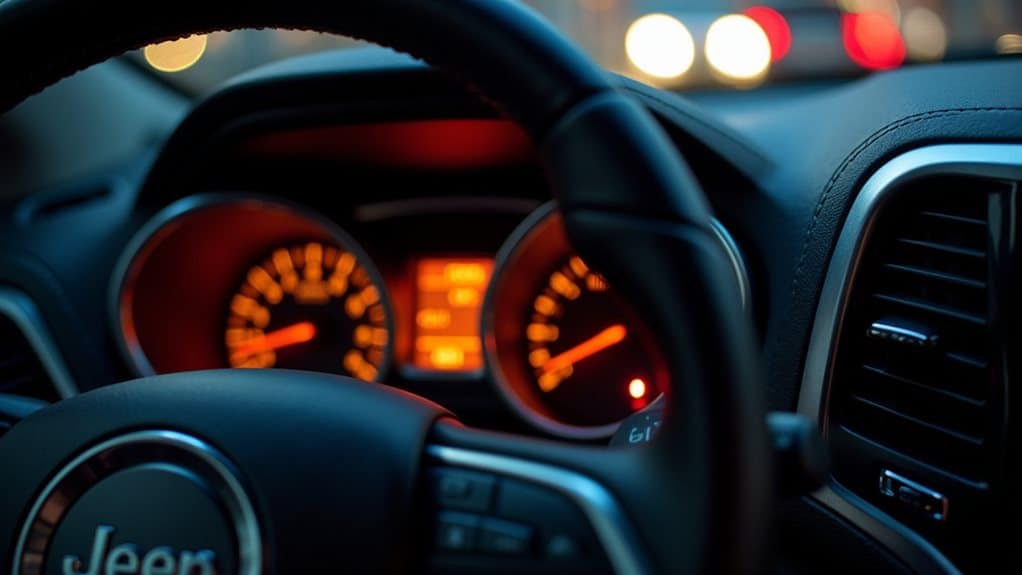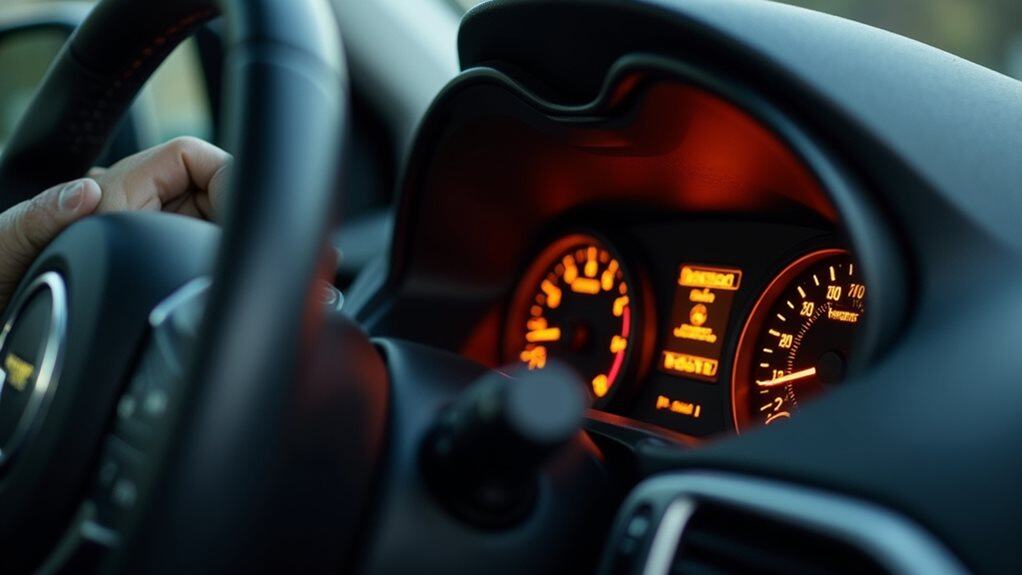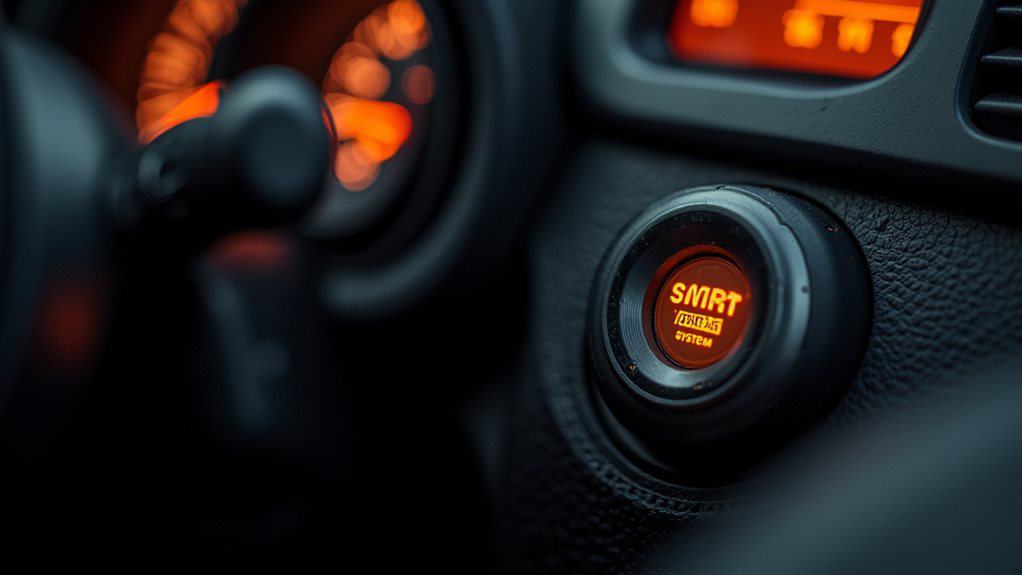If your Jeep Cherokee shows the Service Stop/Start System indicator, it means the automatic engine stop/start has been disabled or faulted and the engine won’t shut off at stops; you can keep driving but will lose fuel-saving stops. Common causes are a weak auxiliary battery, corroded or loose electrical connections, faulty sensors or module communication, or HVAC load inhibiting the system. Check battery voltage and terminals, glance at comfort settings, and have diagnostics run to restore function, and continue for troubleshooting steps.
Quick Tips
- The warning means the Jeep Cherokee’s automatic engine Stop/Start is disabled or malfunctioning, so the engine won’t shut off automatically at stops.
- Most common causes are a weak auxiliary battery, poor electrical connections, sensor faults, or control module communication errors.
- Check auxiliary battery voltage (≈12.6V at rest, ≈13.8–14.2V while charging) and inspect terminals for corrosion or loose connections.
- Temporary inhibitors include heavy HVAC/heated-seat loads or low battery state of charge; reducing loads can restore Stop/Start function.
- Dealer diagnostics typically read fault codes, test battery/alternator, inspect wiring/grounds, and replace the auxiliary battery or sensors if necessary.
What the Service Stop/Start System Warning Means

When the Service Stop/Start System warning appears—often shown as an “A” icon or a similar symbol—it tells you the vehicle’s automatic engine stop/start feature is disabled or not working properly, so the engine won’t shut off automatically at a stop to save fuel.
You can still drive safely, but expect reduced fuel efficiency; diagnostics, battery checks, or sensor inspections will restore function. The warning often indicates a battery issue. A common related problem is that a failing alternator can lead to battery drain, which may trigger the stop/start system warning.
Common Causes Behind the Indicator Light
You’ll often see the stop/start warning when the auxiliary (secondary) battery is weak or failing, because that battery is dedicated to powering the system’s electronics and can’t maintain the required charge.
Electrical supply faults — including corroded or loose terminals, damaged wiring, or poor grounding — interrupt communication between sensors and the control module, so the system disables as a protective measure. The fuel pump control module and related wiring can also be affected by grounding and corrosion issues that impact overall vehicle electronics.
Finally, climate control inhibition occurs when heavy HVAC loads or incorrect cabin temperature sensor readings prevent the system from engaging, since the stop/start function won’t operate if it can’t guarantee passenger comfort or engine temperature within safe limits.
A professional diagnostic scan will identify whether the issue is battery, sensor, or software related, helping target the correct repair for the auxiliary battery.
Auxiliary Battery Failure
Frequently, auxiliary battery failures are the root cause of a Service Stop/Start system indicator on the Jeep Cherokee, and understanding why requires looking at charge, parasitic draw, charging system behavior, and installation issues.
You should check aux battery state of charge (below ~12.6V triggers errors), inspect for parasitic drains, verify alternator output near 13.9V, and make certain clean, secure terminals and proper installation.
Electrical Supply Faults
Electrical supply faults are a common root cause of the Service Stop/Start system indicator on a Jeep Cherokee, and they arise whenever components that measure, deliver, or control electrical power behave incorrectly.
Check the Intelligent Battery Sensor, battery terminals, stop/start relay, coolant temperature sensor, and wiring looms; faults in any can give false warnings, disable auto stop/start, and need diagnostic scanning or repairs.
Climate Control Inhibition
When the climate control system is inhibited, the vehicle can’t rely on predictable cabin temperature control and that can trigger the Service Stop/Start indicator because the stop/start logic depends on accurate thermal and airflow data; you should consequently treat HVAC faults as potential causes of the indicator light.
Check blend door actuators, refrigerant levels, sensors, filters, and software calibrations, since each can disrupt temperature feedback.
How the Auxiliary Battery Affects Stop/Start Performance
Supporting the Stop/Start system, the auxiliary battery powers accessories and vehicle control modules during engine-off periods so the engine can shut down without interrupting critical functions.
If that battery is weak or below about 13.0V, Stop/Start can disable, display warnings, or fail to restart reliably.
You’ll notice reduced fuel savings, higher emissions, and potential extra load on the main battery.
Regular checks with a multimeter can help confirm the auxiliary battery’s voltage and health; a reading around 12.6V indicates a fully charged battery.
Quick Checks You Can Do Before Visiting a Dealer

Before you take your Jeep to the dealer, run a few straightforward checks that often reveal why the Stop/Start system won’t engage, and many of them you can do with basic tools in your driveway.
Inspect battery terminals and the auxiliary battery, clean and tighten connections, check voltage with a multimeter, verify the Intelligent Battery Sensor and starter/alternator, and scan EVIC for Stop/Start error messages. The alternator should maintain approximately 13.8–14.2 volts to keep the battery properly charged and support the Stop/Start system.
When Environmental or Comfort Settings Prevent Auto Stop
After you’ve checked the battery, sensors, and basic driveline components, look next at environmental and comfort settings, since these often stop the Auto Stop-Start from engaging even when the electrical system seems fine.
Check engine and transmission temperatures, HVAC demand, defrost and seat-heater use, and extreme outside temperatures; the EVIC may display why Stop-Start is inhibited, so adjust settings accordingly.
Diagnostic Steps Dealers Use to Find the Fault

When dealers diagnose a non‑functioning Stop‑Start system, they follow a structured process that narrows the cause from simple to complex so you get a reliable repair recommendation; technicians will first verify battery and charging health, then move methodically through sensors, control modules, and electrical loads.
You’ll get voltage and alternator tests, sensor signal checks, module code reads, wiring inspections, and load analysis to pinpoint faults.
Repair and Reset Options for Persistent Warnings
If the Service Stop‑Start warning keeps appearing, you’ll want a clear plan that covers both quick resets and deeper repairs so the system is reliable again.
Start with a scan tool to read codes and check auxiliary battery health, replace that battery if faulty, then disconnect power 10–15 minutes to reset.
If warnings persist, seek dealer reprogramming, sensor replacement, or ECU recalibration.
Wrapping Up
You’ll see the Service Stop/Start System warning when the Cherokee’s auto stop feature can’t operate normally, and you should treat it as a prompt to check basics first. Confirm battery health, accessory load, and climate settings, then clear temporary faults by cycling ignition; if the light persists, expect dealer diagnostics using scan tools and system tests. Repairs range from battery replacement to sensor or module repairs, after which the technician will reset the fault memory and verify proper function.

